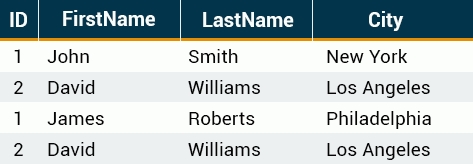(JOIN, Table Operations 03) UNION 연산자
SoloLearn SQL 번역
Set Operation
연산 설정하기
- Occasionally, you might need to combine data from multiple tables into one comprehensive dataset.
- 때로는 여러 테이블의 데이터를 하나의 종합적인 dataset으로 결합해야 할 수도 있다.
- This may be for tables with similar data within the same database or maybe there is a need to combine similar data across databases or even across servers.
- 이는 동일한 데이터베이스 내에서 유사한 데이터를 가진 테이블일 수도 있다.
- 데이터베이스 또는 여러 서버에서 유사한 데이터를 결합해야 할 수도 있다.
- To accomplish this, use the
UNIONandUNION ALLoperators.- 이를 수행하기 위해,
UNION과UNION ALL연산자를 사용한다.
- 이를 수행하기 위해,
UNIONcombines multiple datasets into a single dataset, and removes any existing duplicates.UNION은 여러 dataset들을 하나의 dataset으로 결합하고, 기존 중복들을 제거한다.
UNION ALLcombines multiple datasets into one dataset, but does not remove duplicate rows.UNION ALL은 여러 dataset들을 하나의 dataset으로 결합하지만, 중복 row들을 제거하지는 않는다.
UNION ALL is faster than UNION, as it does not perform the duplicate removal operation over the dataset.
UNION ALL은 dataset에 대해 중복 제거 연산을 하지 않으므로, UNION보다 빠르다.
UNION
UNION 연산자
- The
UNIONoperator is used to combine the result-sets of two or more SELECT statements.UNION연산자는 두 개 이상 SELECT 문의 result-set을 결합하는 데 사용된다.
- All SELECT statements within the UNION must have the
same number of columns.- UNION의 모든 SELECT 문은
동일한 수의 column을 가져야 한다.
- UNION의 모든 SELECT 문은
- The columns must also have the same
data types.- column의
데이터 타입도 동일해야 한다.
- column의
- Also, the columns in each SELECT statement must be in the same order.
- 각 SELECT 문의 column도 동일한 순서여야 한다.
- The syntax of UNION is as follows:
- UNION의 구문은 다음과 같다.
SELECT column_name(s) FROM table1
UNION
SELECT column_name(s) FROM table2;
- Here is the
Firstof two tables:- 다음은 두 테이블 중
첫 번째테이블이다.
- 다음은 두 테이블 중

- And here is the
Second:- 다음은
두 번째테이블이다.
- 다음은

- For example:
SELECT ID, FirstName, LastName, City FROM First
UNION
SELECT ID, FirstName, LastName, City FROM Second;
- Result:

As you can see, the duplicates have been removed.
보다시피, 중복이 제거되었다.
TIP.
- If your columns don’t match exactly across all queries, you can use a
NULL (or any other)value such as:- column이 모든 query에서 정확히 일치하지 않는다면, 다음과 같은
NULL (또는 다른 값)값을 사용할 수 있다.
- column이 모든 query에서 정확히 일치하지 않는다면, 다음과 같은
SELECT FirstName, LastName, Company FROM businessContacts
UNION
SELECT FirstName, LastName, NULL FROM otherContacts;
The UNION operator is used to combine the result-sets of two or more SELECT statements.
UNION 연산자는 두 개 이상 SELECT 문의 result-set을 결합하는 데 사용된다.
UNION ALL
UNION ALL 연산자
UNION ALLselects all rows from each table and combines them into a single table.UNION ALL은 각 테이블의 모든 row를 선택하고, 하나의 테이블로 결합한다.
- The following SQL statement uses UNION ALL to select data from the
FirstandSecondtables:- 다음 SQL 문은 UNION ALL을 사용해서
First와Second테이블의 데이터를 선택한다.
- 다음 SQL 문은 UNION ALL을 사용해서
SELECT ID, FirstName, LastName, City FROM First
UNION ALL
SELECT ID, FirstName, LastName, City FROM Second;
- Result:

As you can see, the result set includes the duplicate rows as well.
보다시피, result set에는 중복 row도 포함된다.
QUIZ
- Drag and drop from the options below to select name, cost, and bids from the “items” table.
- “items” 테이블에서 name, cost, bids를 선택해라.
- Select only those items whose bids are greater than 123.
- bids가 123보다 큰 item만 선택한다.
SELECT name, cost, bids FROM items
WHERE bids > 123;
- To perform a union operation:
- UNION 연산을 수행하려면,
columns in queries must be the samequery의 column이 동일해야 한다
- Type in the command to unite the query results without removing the duplicates.
- 중복을 제거하지 않고 query 결과를 통합하는 명령어는 무엇인가?
UNION ALL